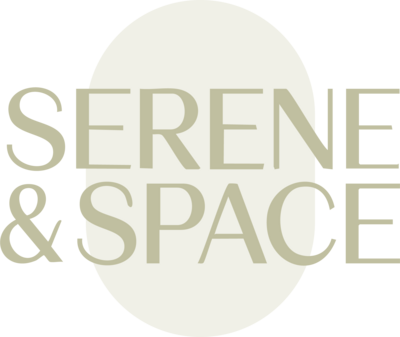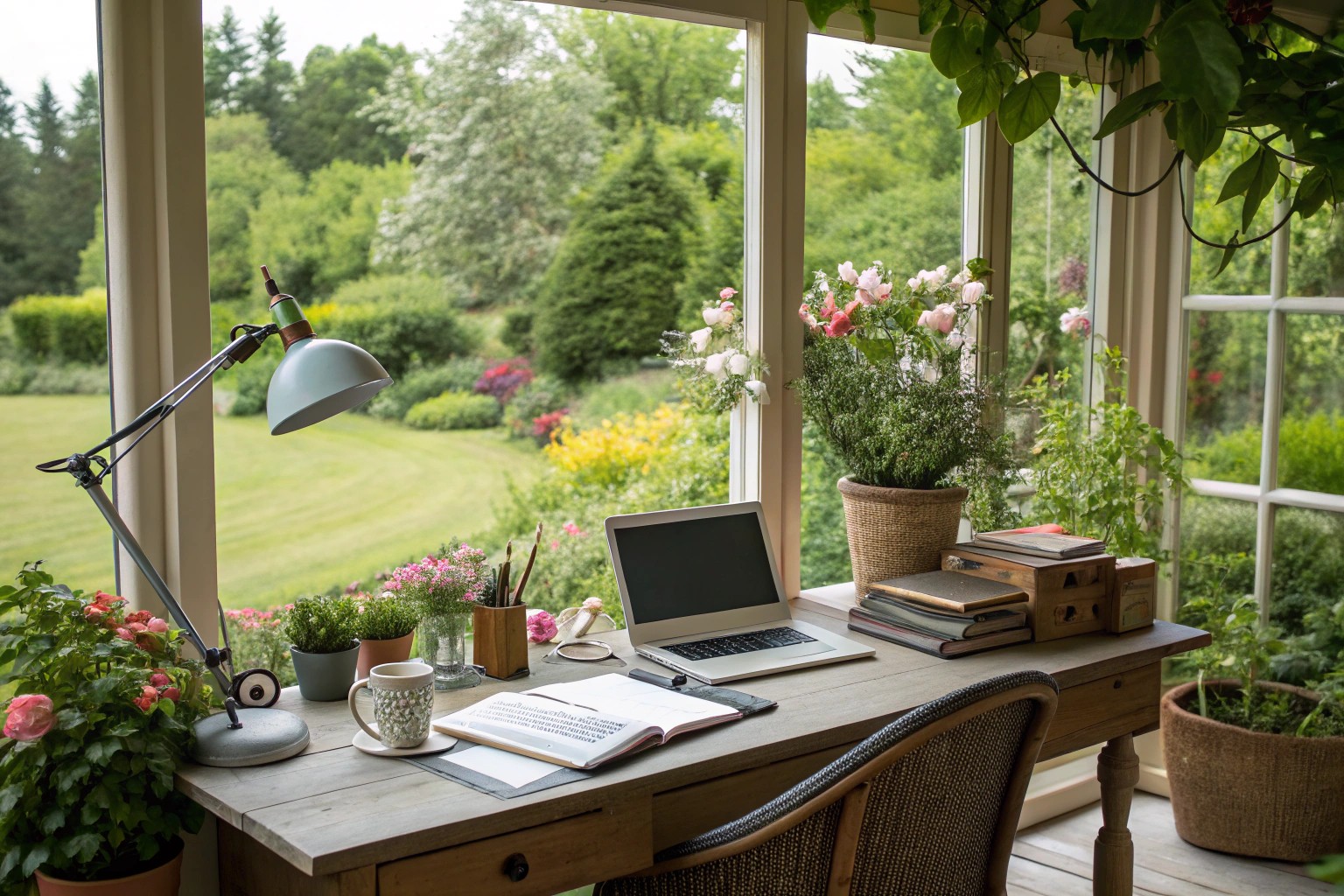The shift toward remote work has transformed how we think about our living spaces, with many professionals discovering that their most productive hours happen not at a traditional desk, but in thoughtfully designed outdoor environments. Whether you’re planning a dedicated garden office or seeking to optimize an existing patio for work, the right outdoor design can dramatically improve both your productivity and quality of life.
Understanding Your Site: The Foundation of Successful Outdoor Workspace Design
Analyzing Solar Patterns and Orientation
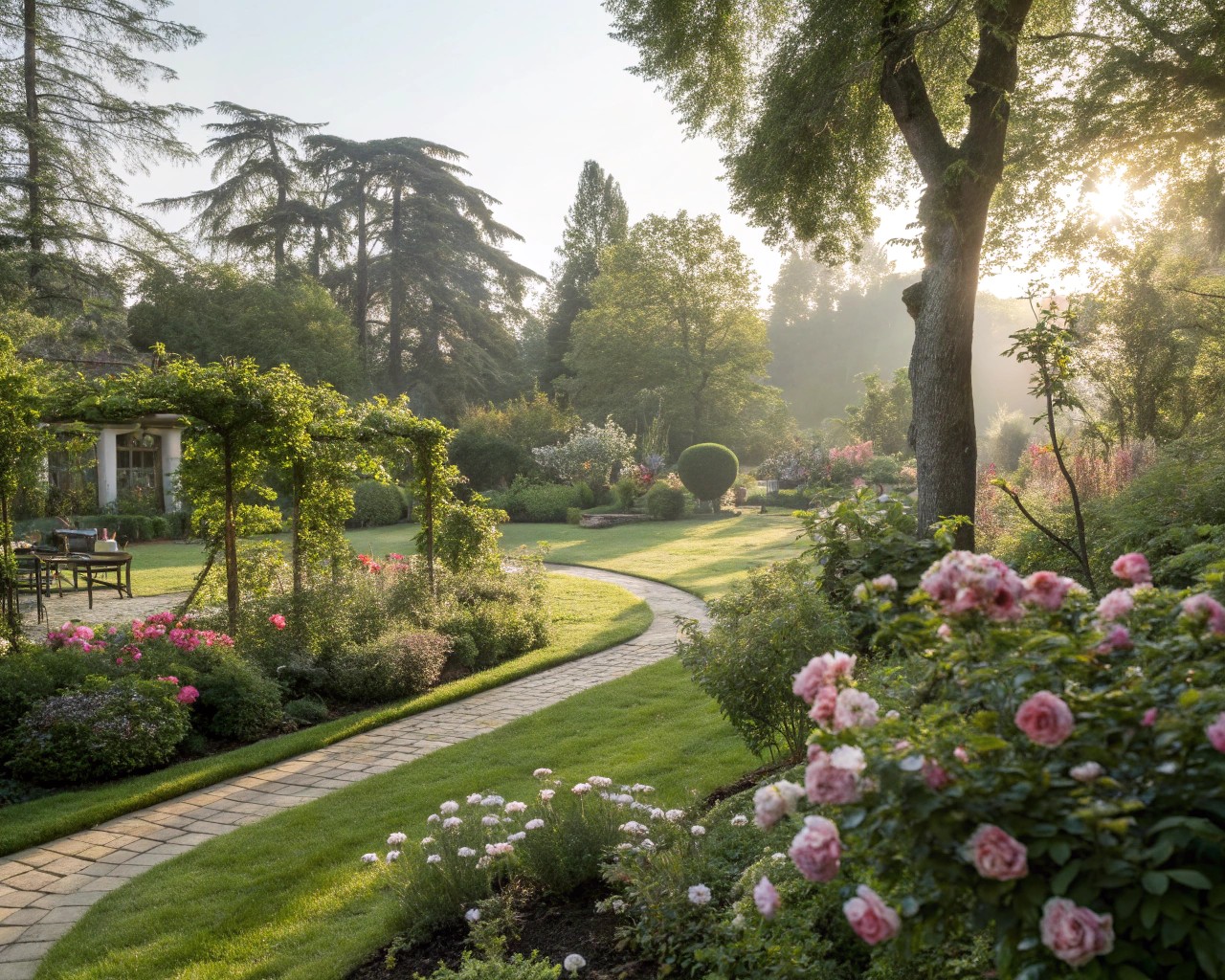
The orientation of your outdoor workspace fundamentally determines its usability throughout the day and seasons. South-facing locations receive the most consistent sunlight, making them ideal for spaces where you want abundant natural light but may require careful shade management during peak hours. I’ve found that clients who work primarily on computer-based tasks benefit most from north or northeast orientations, which provide gentle, consistent lighting without the harsh glare that can make screen work challenging.
To properly assess your site’s solar patterns, spend time in your potential workspace locations at different times throughout a typical workday. Note where shadows fall at 9 AM, noon, and 4 PM, as these represent your primary working hours. West-facing exposures can be problematic for afternoon work sessions due to intense late-day sun and heat buildup.
Consider seasonal variations as well. The sun’s path changes dramatically between summer and winter, with winter sun sitting much lower in the sky. A location that feels perfectly shaded in July might become uncomfortably exposed during autumn and winter months when deciduous trees lose their leaves.
Evaluating Privacy and Sight Lines
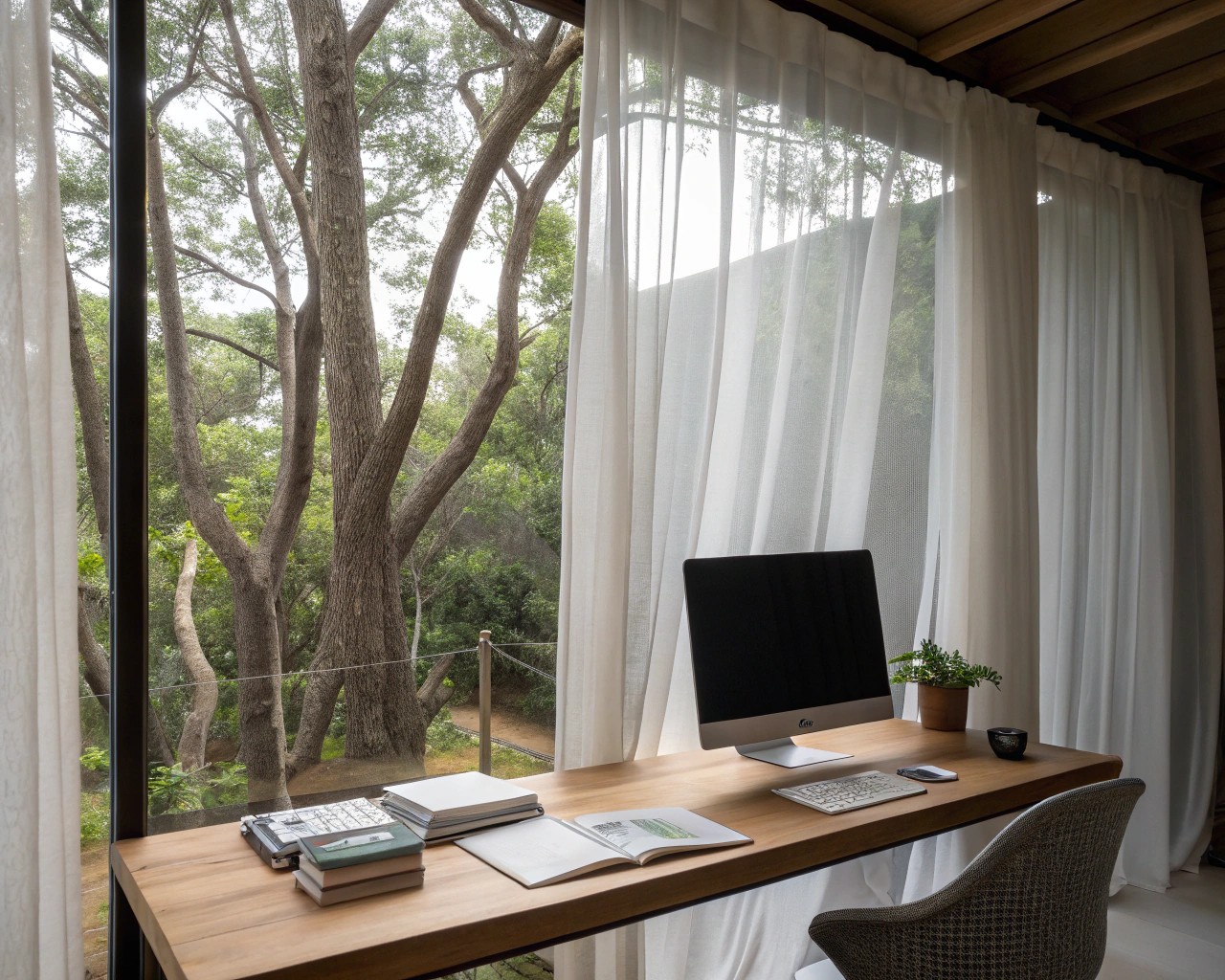
Privacy requirements vary significantly based on your work type and personal preferences. For client-facing video calls, you’ll need different considerations than someone doing primarily independent creative work. Assess sight lines from neighboring properties, especially second-story windows that might overlook your workspace.
Natural screening doesn’t happen overnight, so plan accordingly. Fast-growing privacy trees like Leyland Cypress can reach 6-8 feet in just 2-3 years, while slower-growing options like Oak or Maple may take 5-7 years to provide meaningful screening. For immediate privacy needs, consider combining temporary solutions like outdoor curtains with long-term plantings.
Climate and Microclimate Considerations
Your local microclimate can differ significantly from general regional weather patterns. Areas with low-rise buildings typically experience higher heat stress than locations with taller structures that provide natural shading. Urban heat island effects can make city gardens 5-10 degrees warmer than surrounding areas, particularly important for summer comfort.
Wind patterns deserve special attention. Prevailing winds in most American regions come from the west and southwest, bringing both beneficial cooling breezes and potentially problematic weather exposure. A workspace positioned to capture gentle morning and evening breezes while remaining protected from harsh afternoon winds will be far more comfortable year-round.
Design Fundamentals: Creating Functional Outdoor Work Environments
Space Planning and Layout Principles
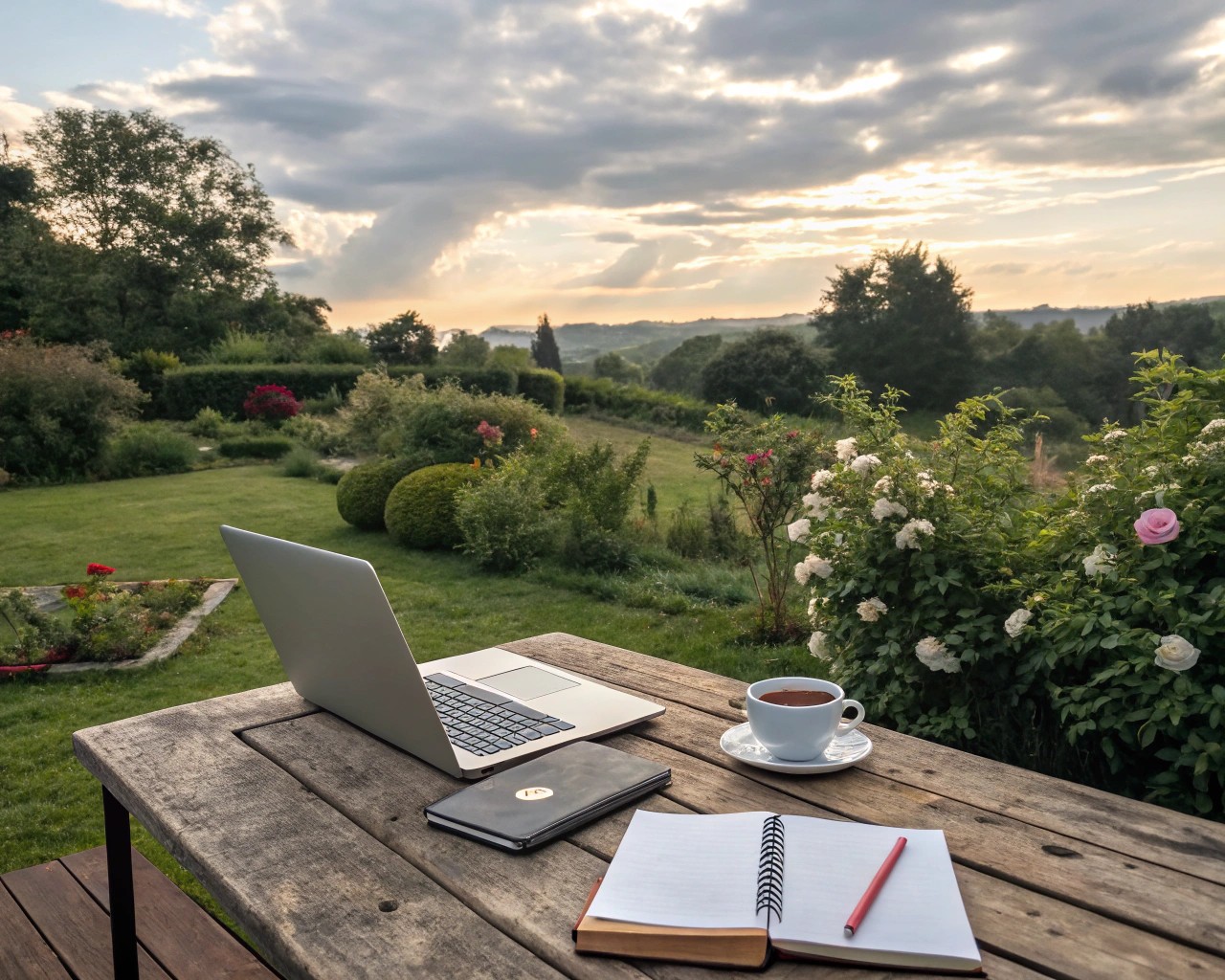
Effective outdoor workspace design begins with understanding your specific work patterns and space requirements. A minimum of 6 feet by 8 feet provides adequate space for a single workstation, including desk area, chair movement, and storage. However, many professionals find that 8 feet by 10 feet offers a more comfortable working environment with room for additional equipment or meeting areas.
Consider your technology requirements early in the planning process. Most outdoor offices require dedicated electrical service for computers, lighting, and climate control equipment. Plan cable routes carefully to avoid future excavation through established plantings or hardscaping.
Workflow efficiency matters as much outdoors as it does inside. Position your primary work surface to take advantage of the best natural lighting while maintaining sight lines to important garden views or activity areas. I often recommend placing desks perpendicular to the longest sight line, which creates a sense of spaciousness while maintaining focus on the immediate work area.
Structural Solutions for Different Budgets and Needs
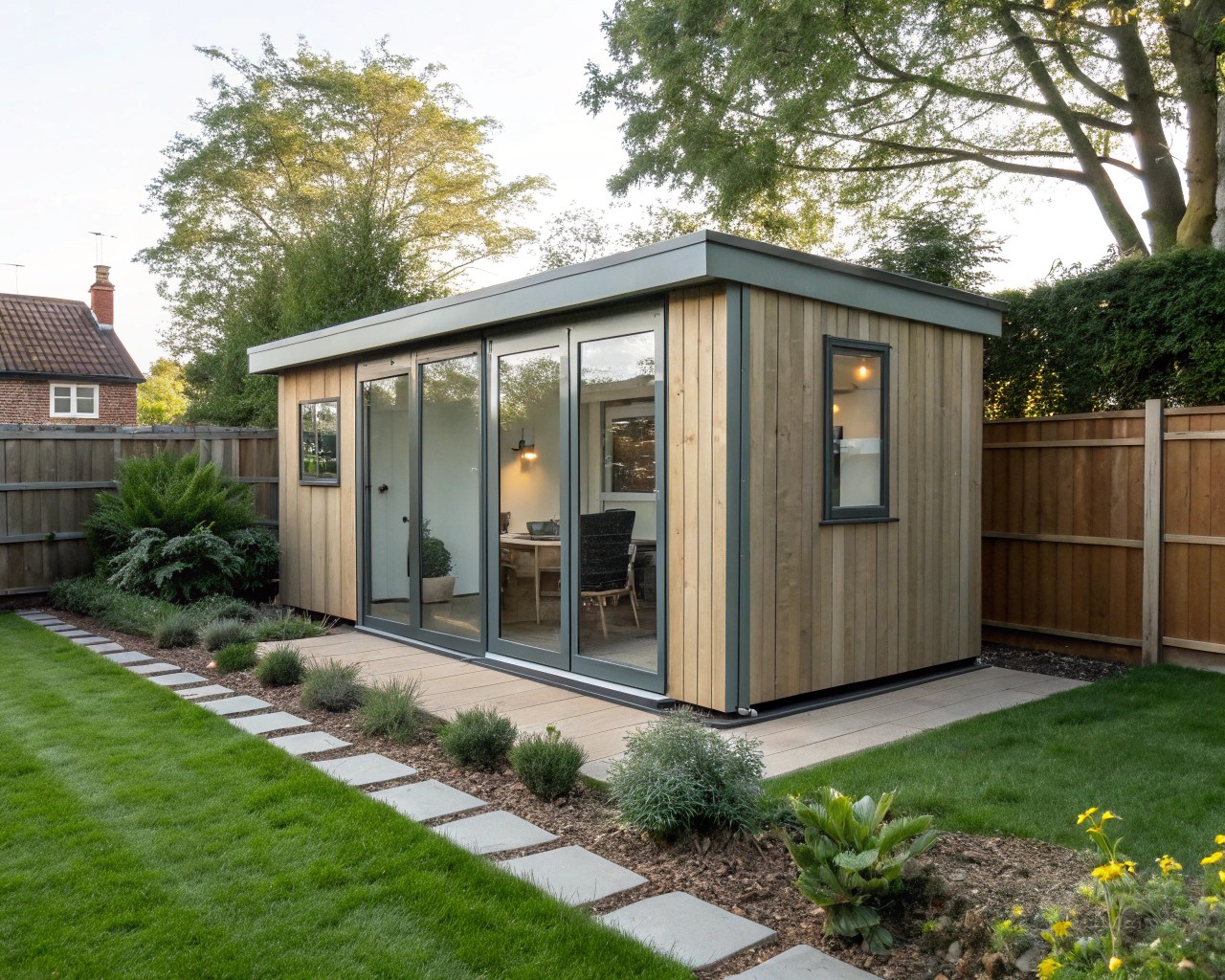
Prefabricated garden office pods offer the most comprehensive solution for dedicated outdoor workspaces, with options ranging from $15,000 for basic models to $75,000+ for high-end custom designs. These structures typically include insulation, electrical systems, and climate control, making them suitable for year-round use in most American climates.
For budget-conscious approaches, converted garden sheds can provide excellent workspace for $3,000-$8,000 when properly insulated and wired. The key to successful shed conversions lies in upgrading insulation, installing adequate ventilation, and ensuring proper moisture control.
Pergola-based workspaces represent a middle-ground option, offering structural definition while maintaining connection to the garden environment. A well-designed pergola can support retractable canopies, outdoor curtains, and even glass walls for seasonal climate control. Costs typically range from $5,000-$20,000 depending on size and features.
| Solution Type | Cost Range | Installation Time | Year-Round Suitability |
|---|---|---|---|
| Prefab Office Pod | $15,000-$75,000+ | 1-2 days | Excellent |
| Converted Shed | $3,000-$8,000 | 1-2 weeks | Good with upgrades |
| Pergola System | $5,000-$20,000 | 3-5 days | Moderate |
| Patio Workspace | $1,000-$5,000 | 1-3 days | Limited |
Integrating Technology and Infrastructure
Modern outdoor workspaces require robust electrical infrastructure to support computers, monitors, lighting, and climate control systems. Plan for at least 20-amp service to your workspace, with separate circuits for high-draw equipment like air conditioning or electric heating.
Internet connectivity often presents challenges in detached outdoor structures. Mesh Wi-Fi systems or dedicated ethernet connections provide the most reliable solutions for professional video conferencing and large file transfers. Consider fiber optic connections for future-proofing if your workspace will handle bandwidth-intensive work.
Weather protection for electronics requires careful planning. Even covered outdoor spaces experience temperature fluctuations and humidity changes that can damage sensitive equipment. Install adequate ventilation systems to prevent condensation buildup, particularly important in humid climates or during seasonal transitions.
Climate Control and Comfort Optimization
Managing Sun and Heat
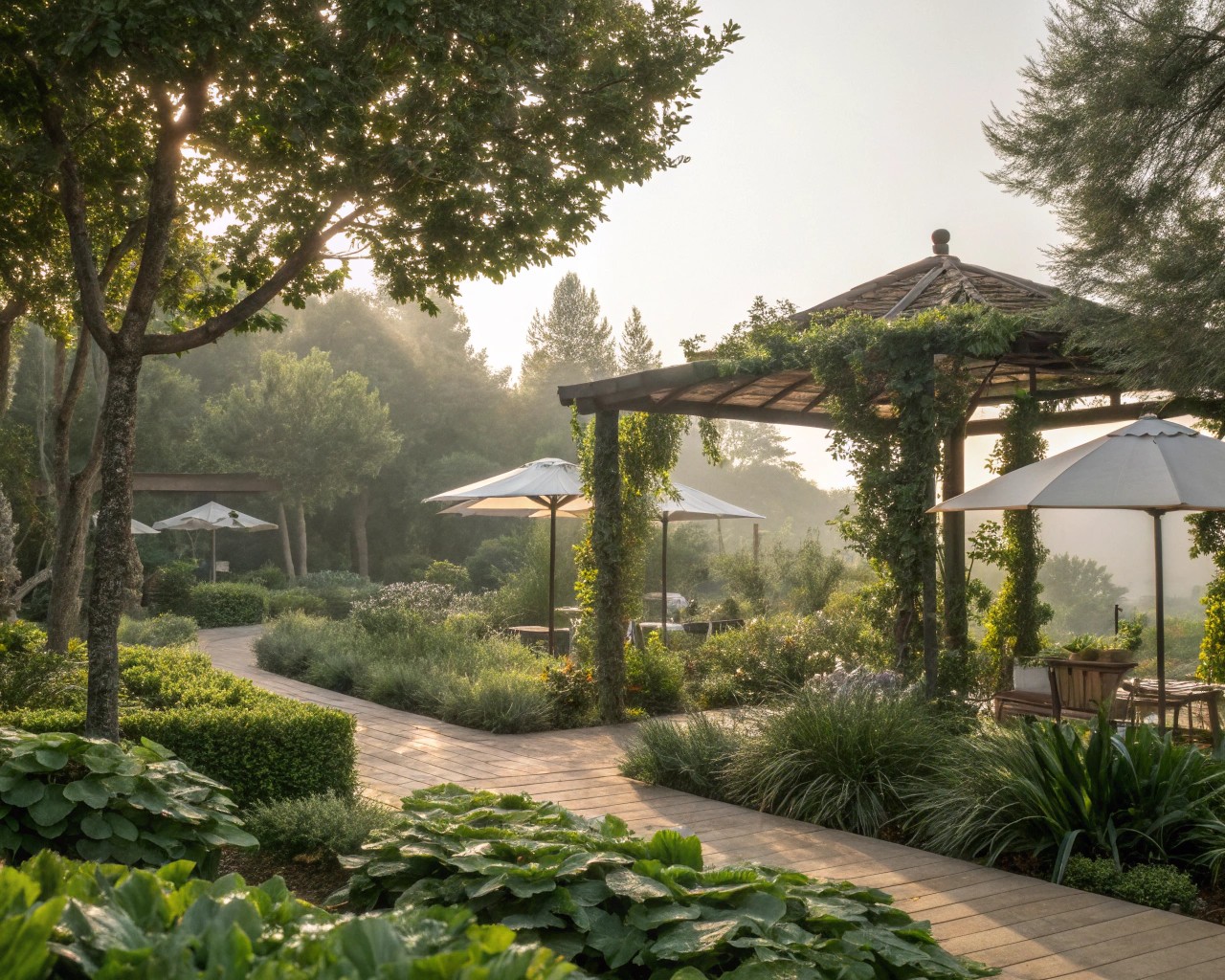
Effective shade management forms the cornerstone of comfortable outdoor work environments during warmer months. Research indicates that proper shading can reduce outdoor temperatures by up to 14°C (25°F), making the difference between unusable and highly comfortable workspace conditions.
Retractable awnings offer excellent flexibility, allowing you to adjust coverage based on sun position and weather conditions. Modern motorized systems can be programmed to respond automatically to sun sensors or integrated with weather monitoring systems for optimal comfort without constant manual adjustment.
Shade sails provide a contemporary alternative that works particularly well in modern garden designs. Their triangular or rectangular forms can be configured to provide coverage exactly where needed while maintaining visual interest. Installation costs typically range from $200-$800 per sail, making them an economical solution for large areas.
Pergolas with adjustable louvered roofs represent the premium shade solution, offering precise control over light levels throughout the day. These systems can be fully automated and integrated with weather sensors to close automatically during rain or high winds.
Ventilation and Air Quality
Natural ventilation provides the most energy-efficient approach to outdoor workspace comfort when properly designed. Cross-ventilation requires openings on opposite sides of enclosed structures, with inlet openings positioned lower than outlets to encourage natural air circulation.
For hot climates or enclosed structures, mechanical ventilation becomes essential for maintaining productivity during summer months. Exhaust fans positioned at the highest point of the structure work with intake vents to create consistent airflow. Size ventilation systems to achieve 6-10 air changes per hour for optimal comfort.
Air quality considerations extend beyond temperature control to include pollen, dust, and urban pollutants that can affect both comfort and health. HEPA filtration systems designed for outdoor use can significantly improve air quality in enclosed garden offices, particularly beneficial for individuals with allergies or respiratory sensitivities.
Seasonal Comfort Strategies
Winter workspace comfort requires different strategies than summer cooling, particularly in northern climates where outdoor spaces might otherwise remain unused for months. Radiant floor heating provides efficient, comfortable warmth without the air circulation that can disturb papers or create drafts.
Electric or gas-powered patio heaters extend the usable season for partially enclosed spaces like pergolas or covered decks. Modern infrared heaters provide instant warmth focused directly on work areas rather than attempting to heat large volumes of air.
Insulation standards for outdoor workspaces should meet or exceed those required for traditional construction in your climate zone. Triple-glazed windows and doors combined with high-performance wall insulation ensure year-round comfort while minimizing energy costs.
Privacy and Screening Solutions
Living Privacy Screens
Strategic plant selection creates privacy screens that improve both aesthetics and environmental conditions around outdoor workspaces. Fast-growing evergreen options like Leyland Cypress, Green Giant Arborvitae, or Eastern Red Cedar can establish effective privacy screens within 3-5 years when planted at 6-8 foot spacing.
For immediate privacy needs, consider layered plantings that combine fast-growing temporary screens with slower-growing permanent solutions. Bamboo species like Graceful Bamboo or Buddha’s Belly can provide 8-12 foot screening within 2-3 years, while oak or maple trees establish the long-term privacy framework.
Dense, low-growing shrubs create privacy at the work surface level without blocking attractive overhead views. Boxwood, Podocarpus, and Holly varieties can be maintained at any height between 3-12 feet, offering flexibility as your needs change.
Understanding your specific privacy requirements helps determine the appropriate screen height. Privacy from first-floor windows requires 6-8 foot screening, while second-story privacy may need 12-15 foot barriers. Consider the mature height of selected plants to avoid future maintenance problems or neighbor conflicts.
Combining Plants with Hardscape Elements
Integrated privacy solutions that combine living and constructed elements often provide the most effective screening while maintaining design flexibility. A 4-foot fence topped with 4-6 feet of planted screening creates immediate privacy while plants establish.
Gabion walls filled with natural stone offer contemporary privacy screening that can support climbing plants or incorporate planting pockets. These systems provide immediate privacy while creating growing conditions for vertical gardens that enhance the workspace environment.
Outdoor curtain systems mounted on pergolas or arbors provide adjustable privacy that can be modified based on specific work activities or seasonal needs. High-quality outdoor fabrics resist fading and weather damage while providing visual privacy and wind protection.
Furniture and Equipment Selection
Ergonomic Considerations for Outdoor Workstations
Outdoor furniture must meet the same ergonomic standards as indoor office equipment while withstanding weather exposure and temperature fluctuations. Adjustable-height desks accommodate different users and work activities, particularly important in multi-use spaces.
Weather-resistant materials like powder-coated aluminum, marine-grade stainless steel, or high-quality synthetic materials provide durability without sacrificing comfort. Teak and other naturally weather-resistant woods offer warmth and beauty but require regular maintenance to preserve appearance and function.
Seating selection significantly impacts long-term comfort and productivity. Ergonomic outdoor office chairs with lumbar support, adjustable arms, and breathable materials prevent fatigue during extended work sessions. Consider chairs with removable cushions that can be stored during inclement weather.
Storage solutions require special attention in outdoor environments. Weather-tight cabinets and filing systems protect important documents and equipment from moisture and temperature extremes. Mobile storage carts allow equipment to be moved indoors during severe weather or extended absences.
Technology Integration and Protection
Outdoor workstations require specialized equipment designed to handle temperature fluctuations, humidity, and UV exposure. All-weather monitors with anti-glare screens perform better than standard indoor equipment moved outside temporarily.
Covered cable management systems protect connections from moisture while maintaining professional appearance. Conduit systems or decorative cable covers route power and data connections safely between structures and equipment.
Weather protection for portable equipment includes waterproof storage for laptops, tablets, and documents during unexpected weather changes. Quick-deploy weather covers allow work to continue during light rain while protecting valuable equipment from damage.
Lighting Design for Productivity
Outdoor workspace lighting must address both functional needs and security concerns while complementing the overall garden design. Task lighting for computer work requires different considerations than ambient lighting for meetings or evening use.
LED systems offer energy efficiency and long service life essential for outdoor installations. Adjustable track lighting provides flexibility to modify lighting as workspace needs evolve, while recessed downlights offer clean, unobtrusive general illumination.
Natural light integration remains crucial even with excellent artificial lighting systems. Position work surfaces to take advantage of indirect natural light during peak working hours while avoiding glare and heat buildup.
Plant Selection and Garden Integration
Plants That Enhance Productivity
Research consistently demonstrates that proximity to plants improves focus, reduces stress, and enhances creativity in work environments. Strategic plant selection around outdoor workspaces can amplify these benefits while contributing to privacy, climate control, and aesthetic appeal.
Office plants that thrive in outdoor conditions include Peace Lily, Rubber Tree, and various Dracaena species when grown in containers that can be moved for winter protection. These plants specifically improve air quality while providing the psychological benefits associated with green environments.
Fragrant plants positioned near workspaces can enhance mood and productivity when selected carefully. Lavender, rosemary, and mint varieties provide pleasant, subtle scents that don’t overwhelm during concentrated work. Avoid strongly fragrant plants like jasmine or gardenia that might become distracting during important calls or detailed work.
Native plant selections reduce maintenance requirements while providing habitat for beneficial wildlife that enhances the outdoor work experience. Consult your local extension office for native alternatives to common landscape plants that provide similar aesthetic benefits with reduced water and fertilizer needs.
Creating Productive Garden Views
Visual connections to well-designed garden spaces improve mental well-being and work satisfaction compared to views of hardscape or neighboring structures. Design garden views that provide visual interest throughout the seasons without creating distractions during concentrated work.
Layered plantings create depth and seasonal interest while maintaining privacy from neighboring properties. Combine evergreen structure plants with deciduous flowering trees and perennial borders for year-round appeal. Position colorful or dramatic elements outside the direct work sight line to provide pleasant break views without constant distraction.
Water features positioned within sight but not sound of the workspace provide visual interest without interfering with phone calls or video meetings. Small fountains or bubbling containers offer the psychological benefits of water without overwhelming audio systems.
Wildlife-attracting plants enhance the outdoor work experience while supporting local ecosystems. Bird-attracting plants and native pollinator gardens provide dynamic, ever-changing views that reduce work stress and enhance creativity.
Maintenance Considerations for Working Gardens
Low-maintenance plant selections ensure that garden care doesn’t interfere with work productivity during busy periods. Drought-tolerant plants, slow-growing evergreens, and self-seeding annuals provide beauty with minimal intervention.
Irrigation systems become essential for maintaining garden health around outdoor workspaces, particularly during summer months when regular hand watering might interrupt work schedules. Drip irrigation or soaker hose systems provide efficient watering without creating mud or splash that could affect outdoor equipment.
Seasonal garden tasks should be planned to minimize disruption to work activities. Schedule major maintenance like pruning, fertilizing, or pest control during off-hours or planned work breaks to maintain both garden health and workspace functionality.
Integrated pest management becomes crucial in outdoor workspaces where chemical treatments might affect human health or comfort. Beneficial insect habitats, companion planting, and mechanical controls often provide effective pest management without compromising workspace air quality.
Sustainable Design and Long-Term Planning
Energy Efficiency and Resource Conservation
Solar power systems offer excellent return on investment for outdoor workspaces, particularly those used regularly throughout the year. Modern solar panels can power lighting, fans, small appliances, and even air conditioning units in appropriately sized installations.
Rainwater harvesting systems reduce irrigation costs while providing backup water supplies during drought periods. Simple barrel systems collect roof runoff for garden irrigation, while more sophisticated systems can supply workspace restrooms or kitchenettes.
Energy-efficient building materials and systems reduce both environmental impact and operating costs. High-performance insulation, LED lighting, and ENERGY STAR appliances provide long-term savings that often offset higher initial investment costs.
Native and adapted plant selections dramatically reduce water and fertilizer requirements compared to conventional landscape plants. These choices often provide superior wildlife habitat while reducing long-term maintenance costs and environmental impact.
Planning for Changing Needs
Flexible design solutions accommodate evolving work patterns and family needs over time. Modular furniture systems, removable partitions, and adaptable storage solutions allow workspace reconfiguration without major renovation costs.
Multi-purpose design considerations ensure that outdoor workspaces remain valuable even if work patterns change significantly. Spaces designed to function as workshops, art studios, or entertainment areas maintain utility regardless of employment changes.
Future expansion possibilities should be considered during initial planning to avoid costly modifications later. Underground utilities, oversized electrical service, and foundation systems that support additional construction provide cost-effective expansion options.
